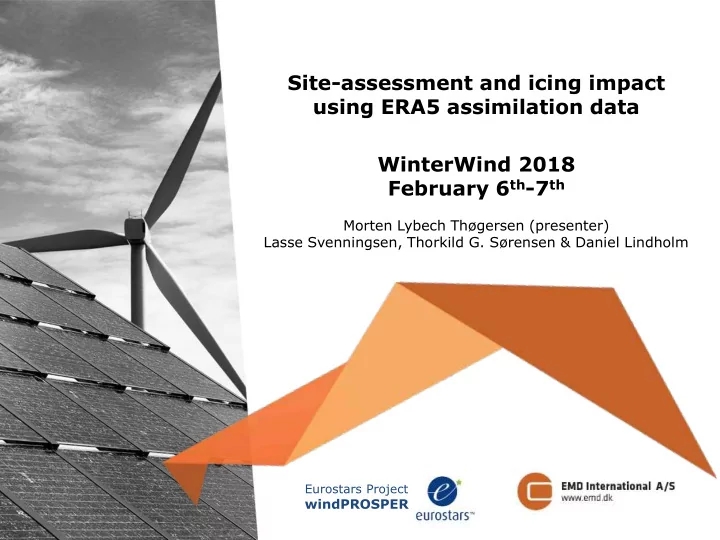

Site-assessment and icing impact using ERA5 assimilation data WinterWind 2018 February 6 th -7 th . Morten Lybech Thøgersen (presenter) Lasse Svenningsen, Thorkild G. Sørensen & Daniel Lindholm Eurostars Project windPROSPER
Contents 1. Brief introduction to ERA5 2. Expectation and motivation for this study 3.A Sensitivity – to boundary data (ERA5, CFSR, ERA-I, MERRA2) 3.B Sensitivity – to model resolution and microphysics scheme 3.C Comparison to sites 4. Findings / Conclusions ERA-Interim ERA5 MERRA-2 1. Conclusions Wind Speeds
1. What is ERA5? - Overview ECMWF most recent reanalysis dataset (5 th generation) • Higher temporal and spatial resolution that ERA-Interim • New parameters available – such as 100m winds • Released so far 7 years have been released as first segment (2010-2016) • Continious updating (December 2017) • Full coverage 2017 (February 2018) • Still under development Item Old Plan New Plan (Last Thursday) (Last Friday) ERA5T (short delay product) 2017-Q4 2018 Access to observations 2017-Q4 2018 Years 1979-2009 released 2018-Q2 Late 2018 Years 1950-1978 released 2019-Q1 2019 Public release plan @ http://climate.copernicus.eu/products/climate-reanalysis
1. What is ERA5? – Comparison *) A preliminary version ‘ ERA5T ’ with 1 week delay will be available
1 .What is the performance? R 2 – Correlation – windspeed at 107 masts
1. Modelling Chain OBSERVATIONS ERA-5 RAW DATA EMD-WRF OD DOWNSCALING
1.Why also observations? MetOp-B, 2012-09-17 MetOp-A, 2006-10-16 Credit: Observations assimilated in the MERRA2 datasets for the period 01.1980 until 12.2014. Units are millions per 6 hours. From Bosilovich et al: ‘ MERRA-2: Initial Evaluation of the Climate - Technical Report Serieson Global Modeling and Data Assimilation – Volume 43’
1. Expectations before this study? Could ERA5 in the modelling chain bring improved accuracy for icing (temperature, winds, clouds...) – as has been seen for winds? Observations: Much better model resolution (spatial and temporal) • Improved assimilation model • More data-sources being assimilated in recent years • Method: Run different ‘ensembles’ • Try to quantify any differences (possibly improvements) by looking at • simple metrics such as icing-hours .
WRF Model Setup for This Study WRF Model Setup Resolution (1): 3 km • Resolution (2): 1.5 km • Time Span: 1993-present (ERA5: 2010-2017) • Land Use: Globcover (300m) • WRF Parameterization Schemes Microphysics (1): Ferrier • Microphysics (2): Thompson • Surface layer: Janjic • Planetary boundary layer: Mellor-Yamada-Janjic • Land-surface model: Noah • Radiation: GFDL • Global Boundary Data Icing Model ERA5 (1) Makkonen / ISO 12494 • ERA-Interim (2) In cloud icing on standard cylinder • MERRA2 (3) driven by (downscaled) WRF model parameters • CFSR (4) Pressure, temperature, cloud water, • wind speeds. dm/dt > 10g/h
Current Study – In Three Steps A. Sensitivity to boundary data WRF-Setup: Microphysics Ferrier (1) and Thompson (2) 1 winter of modelling – 2 sites (DK and SE) ERA5 (1) • ERA-Interim (2) • MERRA2 (3) • CFSR (4) • B. Sensitivity to model resolution Boundary data: ERA5 and ERA Interim • Resolution: 3 km & 1.5 km • C. Comparison to local masts Boundary data: ERA5 and ERA Interim • Resolution 3 km • 10 cases • Microphysics: Thompson • Period: Mast Period (typically ~1 year) •
• Part . 3A: Sensitivity to Boundary Data ERA5 vs ERA5 vs ERA5 vs CFS / CFSR MERRA2 ERA-Interim
• Part . 3A: Sensitivity to Boundary Data ERA5 vs ERA5 vs ERA5 vs CFS / CFSR MERRA2 ERA-Interim
3A: Sensitivity to Boundary Data ERA5 ERA-Interim • Part . CFS/CFSR MERRA2
3A: Sensitivity to Boundary Data • Part . Notes: PowerRatio = Yield for 2MW turbine for iced vs. all time-stamps
3A: Sensitivity to Boundary Data • Part . Notes: PowerRatio = Yield for 2MW turbine for iced vs. all time-stamps
3A: Sensitivity to Boundary Data • Part . Notes: PowerRatio = Yield for 2MW turbine for iced vs. all time-stamps Mast: 7.7% instrumental ice = 670h
3B: Sensitivity to Resolution and Microphysics 1.5km - Thompson 3.0km - Thompson 1.5km - Ferrier • Part . ERA5 ERA-Interim
3B: Sensitivity to Resolution and Microphysics • Part . Notes: PowerRatio = Yield for 2MW turbine for iced vs. all time-stamps Mast: 7.7% instrumental ice = 670h
3C: Evaluation on Local Sites Instrumental Icing vs Meteorological Icing on Swedish Sites • Part . ERA5 = WRF with ERA5 and Thompson microphysics, 3km resolution ERA-Interim = WRF with ERA-Interim and Thompson microphysics, 3km resolution
4. Findings / Conclusions! General Conclusion on ERA5: ERA5 as input to WRF - or on its own- is a significant improvement • - over previous reanalysis datasets (at least when looking on winds ERA-Interim is still the preferred choice for long-term wind and icing • - until a longer period of ERA5 data become available (Late 2018) This Icing Study: Comparison directly against instrumental icing is very uncertain • - no clear trend is (yet) identified In average, ERA5 data results in less hours of active icing than ERA-I • - in our case in 9 out of 10 sites Local temperature bias correction is needed • Cloud microphysics scheme seem more important than reanalysis source • More recent (higher) quality validation data and analysis are needed • - before any firm conclusion can be drawn of ERA5 data and icing
Thank you!
Recommend
More recommend